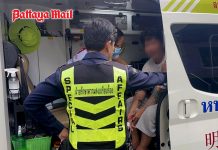
Traditionally auctions with numismatic material start in February, has a break from May until late September and another break in December. There were some exceptions though. The American Numismatic Association had their coin show in August called “World Fair of Money” and the New York International Numismatic Convention holds theirs in December. Several auction companies ran their auctions at the same time as these major conventions or just before or after.
Today, numismatic auctions are conducted all year round. The bidding system and viewing is much improved. One does not necessary have to physically attend the auctions. One can virtually view high resolution pictures of the objects. The auctions have live bidding so the client can participate from wherever they are on the planet.
Several auction companies who used to hold two to four auctions a year are holding them on a monthly basis. The pandemic has definitely affected a change in the auction market much earlier than anticipated. Several new records for numismatic objects have been set in the last couple of years. I do not hope that getting together at auctions and conventions will be history. It is always a pleasure getting together with dealers and collectors socially to discuss and exchange opinions concerning our mutual interest.
Eur-Seree Collecting Company in Bangkok postponed their auction several times because of restrictions from the Government trying to control the pandemic. The CEO Vitoon Eurtivong is of the opinion that it is very valuable having auction sales with the public at present. He even invites dealers during the viewing and auction to set up their tables where they can offer their coins, medals, stamps and banknotes for sale. Eur-Seree Collecting Company will mark their 20th anniversary as an auction company with the 60th Auction Sale on March 5 & 6 in Bangkok.
At the 59th Sale which took place at the Shangri-La Hotel on November 13 and 14, the total sale was THB 51 million including buyers’ premium. The starting price was THB 31,582,600 and the hammer price was THB 45,164,200, an increase of 43.04%. There were 280 floor bidders and 180 absentee and phone bidders. Out of the total number of bidders, 253 bidders bought at least one lot.
There is no doubt that third part graded coins are very popular. The market leaders in third part grading are Numismatic Guaranty Company (NGC) and Professional Coin Grading Service (PCGS). NGC also owns Paper Money Grading (PMG), a company specializing in grading banknotes. Both companies grade coins and banknotes on a scale from 1, the worst grade, and 70 as the very best.
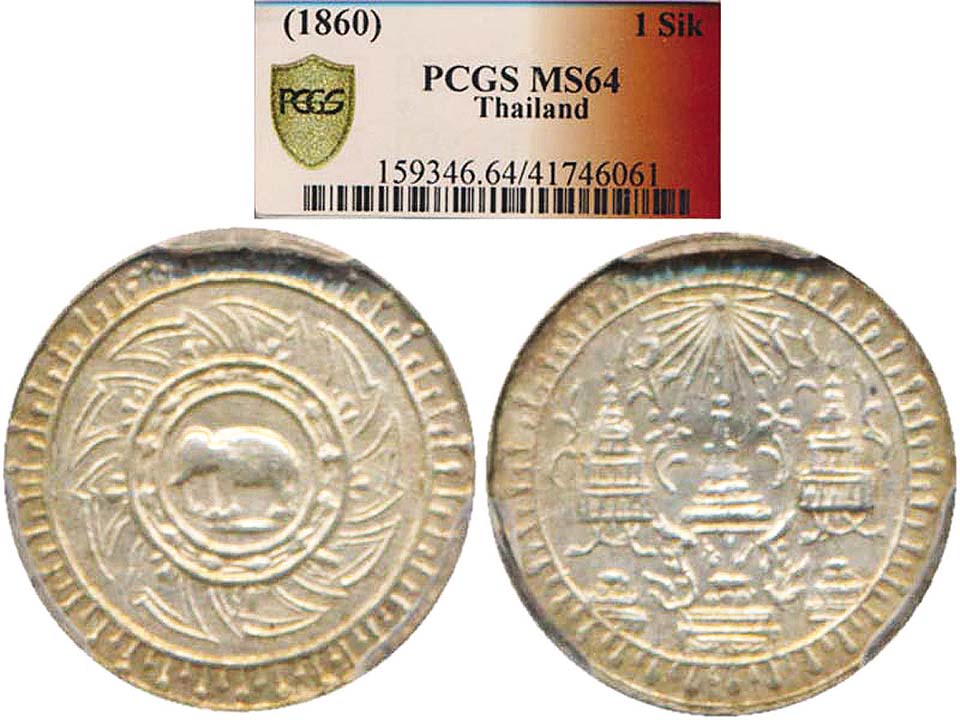

In the Eur-seree sale there was a 1/16 Baht coin, 1 ‘Sik’, ND (1860) struck during the reign of King Mongkut, Rama IV. It is a tiny silver coin with the weight of 1 gram. There are two varieties of this coin, one with small elephant and one with a large elephant. According to the “Standard Catalogue of Thai Coins” by Veerachai Smitasin, the large elephant is rarer. From my experience as a collector I have seen more 1/16 Baht coins with large elephants than with the smaller ones.
The one in the sale had the small elephant, it was graded by PCGS to be MS64, minimum price was THB 10,000 and it sold for THB 68,000. A 1/16 Baht with small elephant graded by NGC as MS61 had a minimum price of THB 6,000 and sold for THB 13,000. Another 1/16 Baht with the large elephant also graded by NGC as MS61 had a minimum price of THB 10,000 and sold for THB 10,000. It is interesting to note how important collectors find the grading, the price for the coin in MS64 was sold for more than five times than a coin in MS61, only three grades higher. The MS in front of the grade stands for MINT STATE.


A 1 Baht ND (1860), another popular coin from the reign of King Mongkut, Rama IV, was graded by NGC to be MS65. According to the NGC Census there are 100 pcs of 1 Baht ND (1860) graded by them from AU55 to MS65. AU stands for ALMOST UNCIRCULATED. Out of these 100 pcs five are graded to be MS65. The minimum price for this 1 Baht in Eur-seree auction was THB 10,000. Many were hoping to get a bargain, but the buyer ended up paying THB 94,000. For another 1 Baht ND (1860) graded by NGC to be AU58 the minimum price was THB 6,000 and it sold for THB 7,000. According to the Census NGC has graded 32 of the 100 pcs to be AU58.

In the year B.E. 2531 B.E. (1988 A.D.) the first bi-metal 10 Baht coins were produced in a mintage of 60,200 pcs. They were delivered from the mint in sacks of 100 coins totalling THB 1,000. An original never opened sack was sold in Eur-seree auction with a starting price of THB 10,000. It sounds like a good investment if sold. The catalogue price according to “Standard Catalogue of Thai Coins” by Verachai Smitasin is THB 400 a coin. The catalogue is an old, but it was a surprise, after brisk bidding, the sack sold for THB 230,000 or THB 2,300 a coin.

The 6000 Baht “700th ANNIVERSARY OF THAI ALPHABET” in gold proof only had a mintage of 235 pcs. The starting price was THB 250,000 and the hammer price was THB 340,000. A similar coin in the same grade was sold in Eur-seree sale #55 on June 21st 2020 for THB 450,000. The minimum price was THB 180,000. I will not say that there was a drop in value, but that the price paid in 2020 was too high.

Many collectors try to put together a complete set of the interesting silver 600 Baht coins. The rarest is the Princess Chulabhorn 600 Baht coin from 1986 in proof condition. In PROOF only 212 pcs were produced while 2,400 pcs were produced in UNC. The one in the auction was in proof condition and had a starting price of THB 100,000 and was bought for THB 340,000. The coin was issued to commemorate Princess Chulabhorn receiving the Einstein medal.

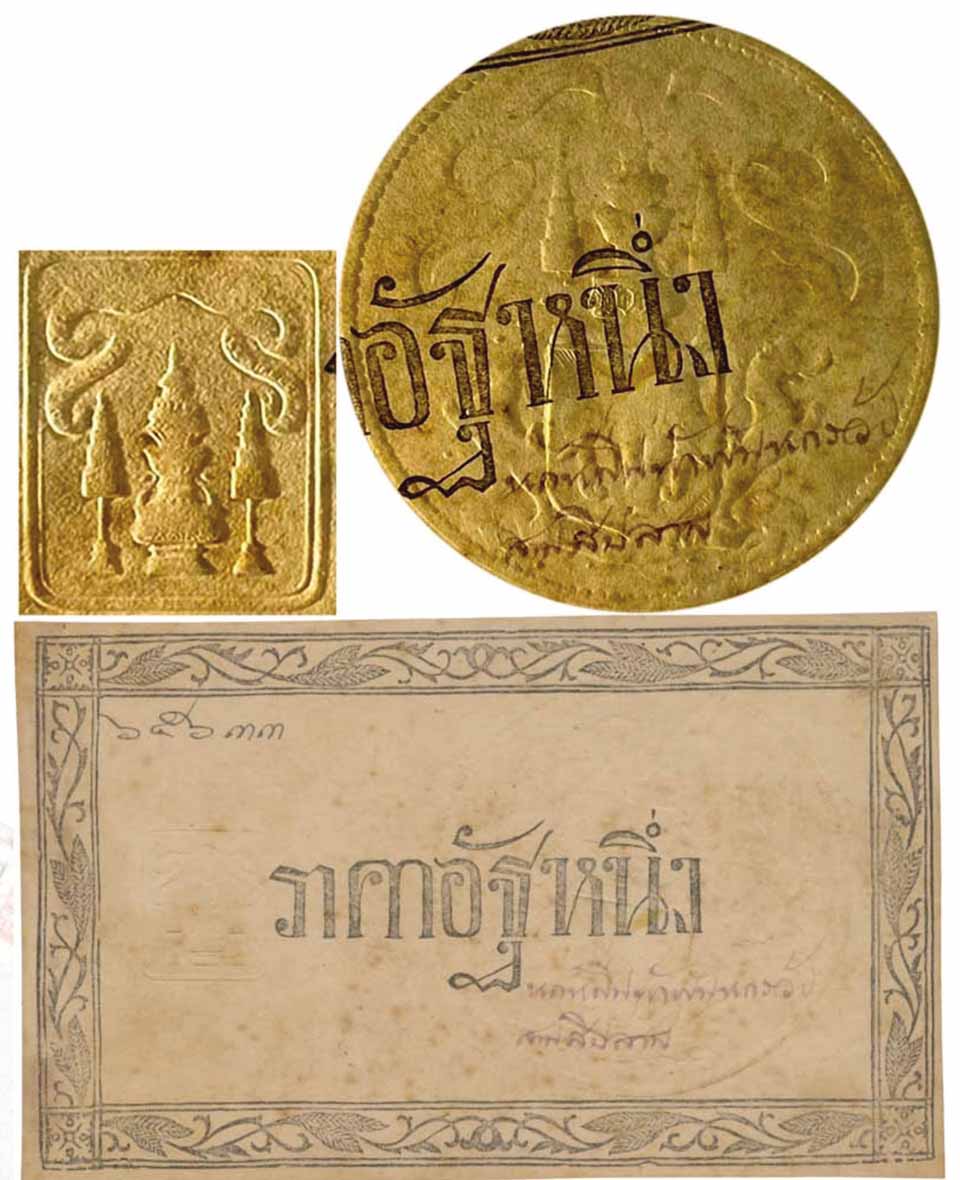
An example of the 1874 Royal Siamese Treasure notes, a One ‘Att’, had a minimum price of THB 350,000. Even though it was only graded as F (FINE), it was a very nice note considering it was produced using poor quality materials available at the time. It is probably one of the nicest in the market. The buyer ended up paying THB 500,000.
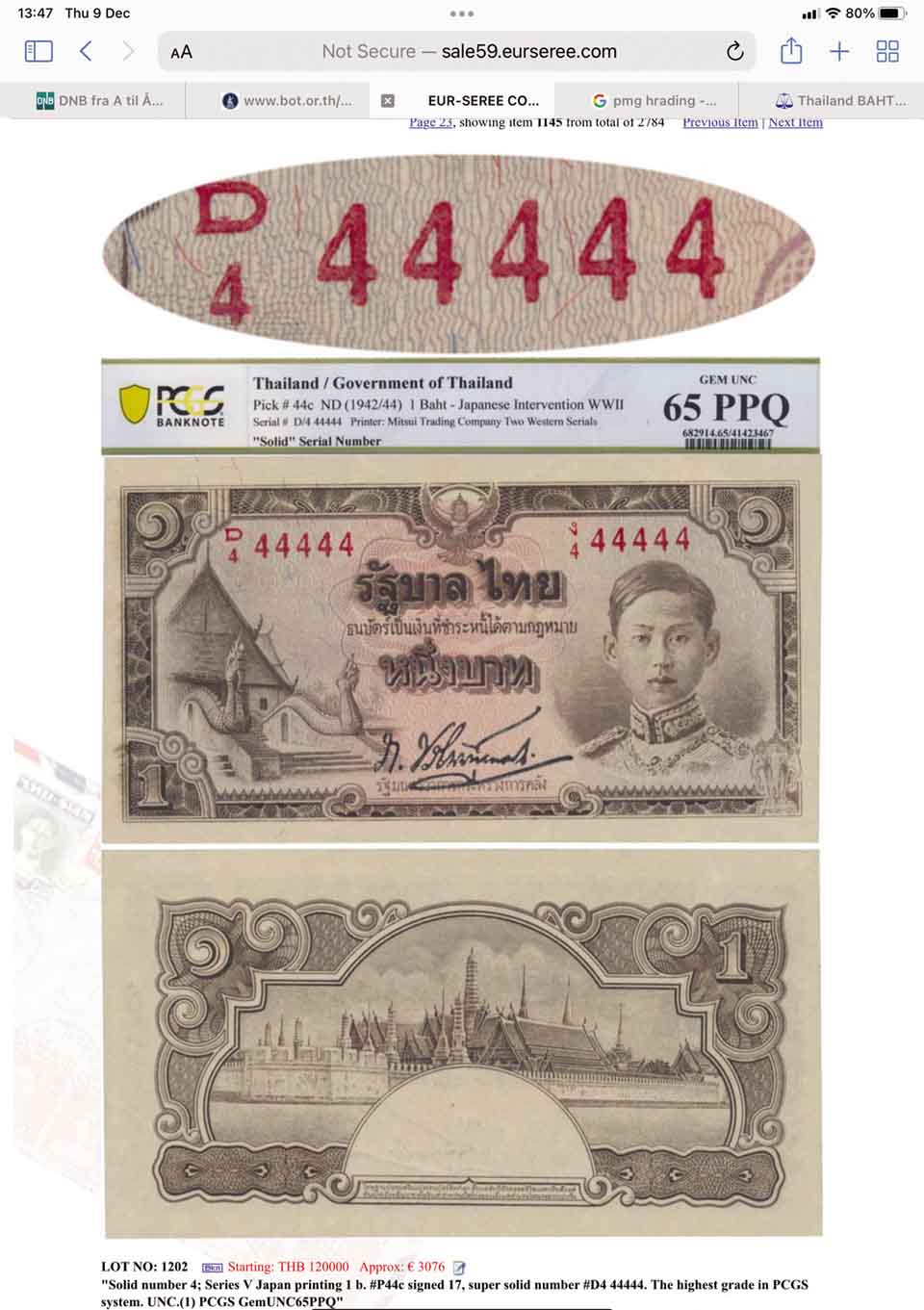
There are many collectors of Solid and Lucky Numbers. The 1 Baht banknote, Series V, Japanese printing had the super solid number D/4 44444. Super solid means that the banknote also has the same number in the serial number as the number of the banknote. The minimum price was THB 120,000 and it sold for THB 200,000. It was graded by PCGS to be GemUNC65PPQ. PPQ stands for Premium Paper Quality.

Another super solid number, which sold for an amazing price, was a 10 Baht, Series 10, with the portrait of H.M. King Bhumibol, Rama IX. The serial number was W/88 and the number 888888. The starting price was THB 40,000. There were several collectors who wanted this special banknote for their collection and the buyer paid THB 310,000. This very same banknote was in Eur-seree auction #14 on December 9, 2007, when at that time no one was interested to buy it and it was unsold for THB 40,000. This time it sold for almost 8 times more than when it was offered 14 years ago.

Three SPECIMEN banknotes from King Ananda, Rama VIII, Series III, Type II were auctioned. A 10 Baht note dated 15th of October 1936 with serial number N/50, the last serial number for this banknote, perforated “CANCELLED” had a starting price of THB 125,000 with the buyer paying exactly that amount.

A 20 Baht dated 1st of October 1936 with serial number P/20, the last serial number for this banknote, perforated CANCELLED, had a starting price of THB 115,000 and sold for THB 150,000. The 20 Baht banknotes from this series are much rarer than the 10 baht banknotes, something that is reflected in the catalogues.

Thomas de la Rue & Company Limited London (TdlR) printed banknotes for Thailand from 1902 until 1969 when Thailand set up Note Printing Works, Bank of Thailand. On some of the SPECIMEN banknotes TdlR stamped them with the black or red oval “SPECIMEN DE LA RUE & Co LTD. CANCELLED” stamp. These are very popular as they are interesting and the stamp is decorative. A 10 Baht dated 15th May 1936, Serial number N/35, with the TdlR oval red stamp in lower right corner, “SPECIMEN No. 14” stamped and written in lower left margin, had a starting price of THB 160,000 and sold for that price. It was graded by PMG to be 63, Choice Uncirculated. It had traces of glue on the back left border. This is very common for SPECIMEN banknotes from the archives of TdlR as they had them mounted.
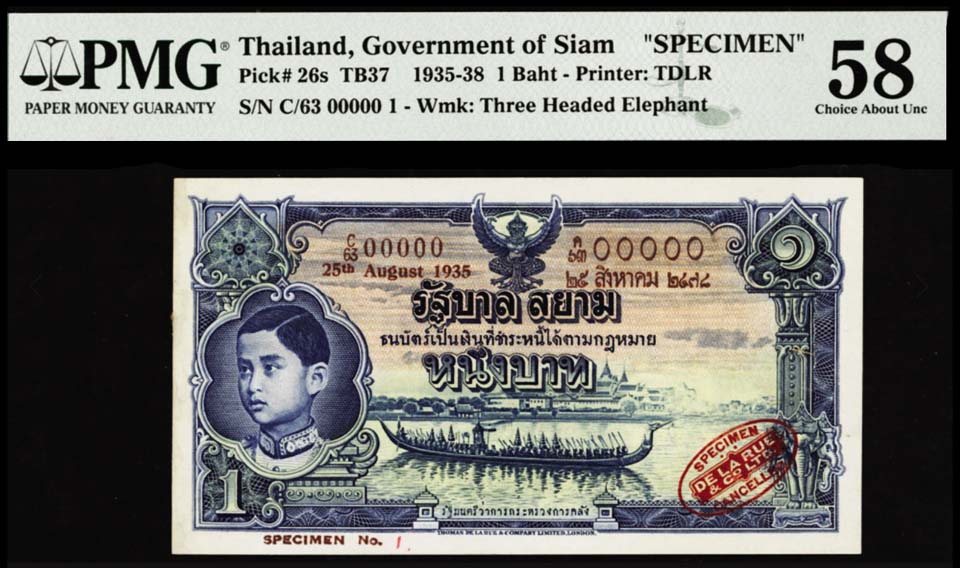

Spink, London conducted their World Banknotes on October 27 for open doors. Not so many people attended the auction, but there were many active bidders both on live auction and by telephone. From Thailand there were three interesting SPECIMEN banknotes produced by TdlR. I was informed that the three banknotes were not consigned by TdlR. The family of a former employee of TdlR consigned them. A One Baht, Third Series, Type II, dated 29th August 1935 with serial number C/63, graded by PMG58, was estimated at GBP 1,500-1,800. The note had the TdlR oval red stamp in the lower right corner and in lower left margin stamped and written “SPECIMEN No. 1” The buyer had to pay GBP 2,400 plus commission, a total of about THB 134,000.


A 10 Baht, Third Series, Type II, dated 15th May 1936 with serial number N/35, graded by PMG to 63. The note has the red, oval TdlR stamp in the lower right corner. This is similar to the one sold in Eur-seree auction with “SPECIMEN No. 14”, but this had “SPECIMEN No. 1” stamped and written in the lower left margin. The banknote was estimated at GBP 1,500-1,800. The buyer ended up paying GBP 3,000 plus commission, a total of about THB 167,000. The first specimen is always popular.
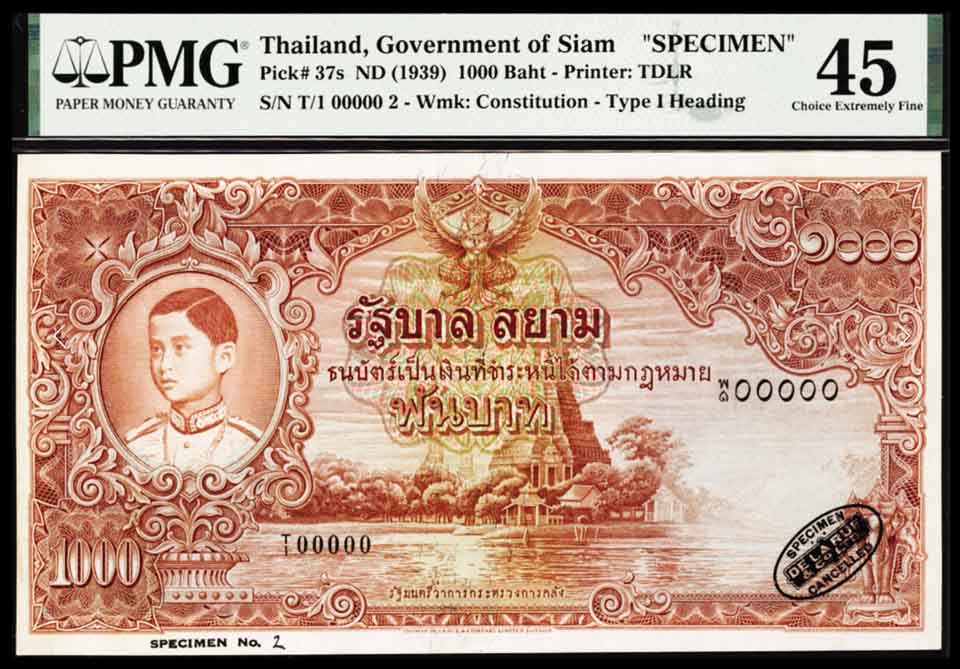

Spink, London also sold a 1000 Baht note considered to be the Fourth Series, Type II. Actually I think it “belongs” to Third Series. Type I has the legend “GOVERNMENT OF SIAM”. Type II was sold in the auction and has the legend “THAI GOVERNMENT”.
The banknote was announced on March 7, 1940. It has the serial number T/1, has the oval black TdlR in the lower right corner and is stamped and written “SPECIMEN no. 2” in the lower left margin. PMG graded the note to be 45. The estimation was GBP 3,000-4,000.The buyer ended up paying GBP 3,800 plus commission, a total of about THB 230,000. The price would probably have been be higher if this was “SPECIMEN no.1”.
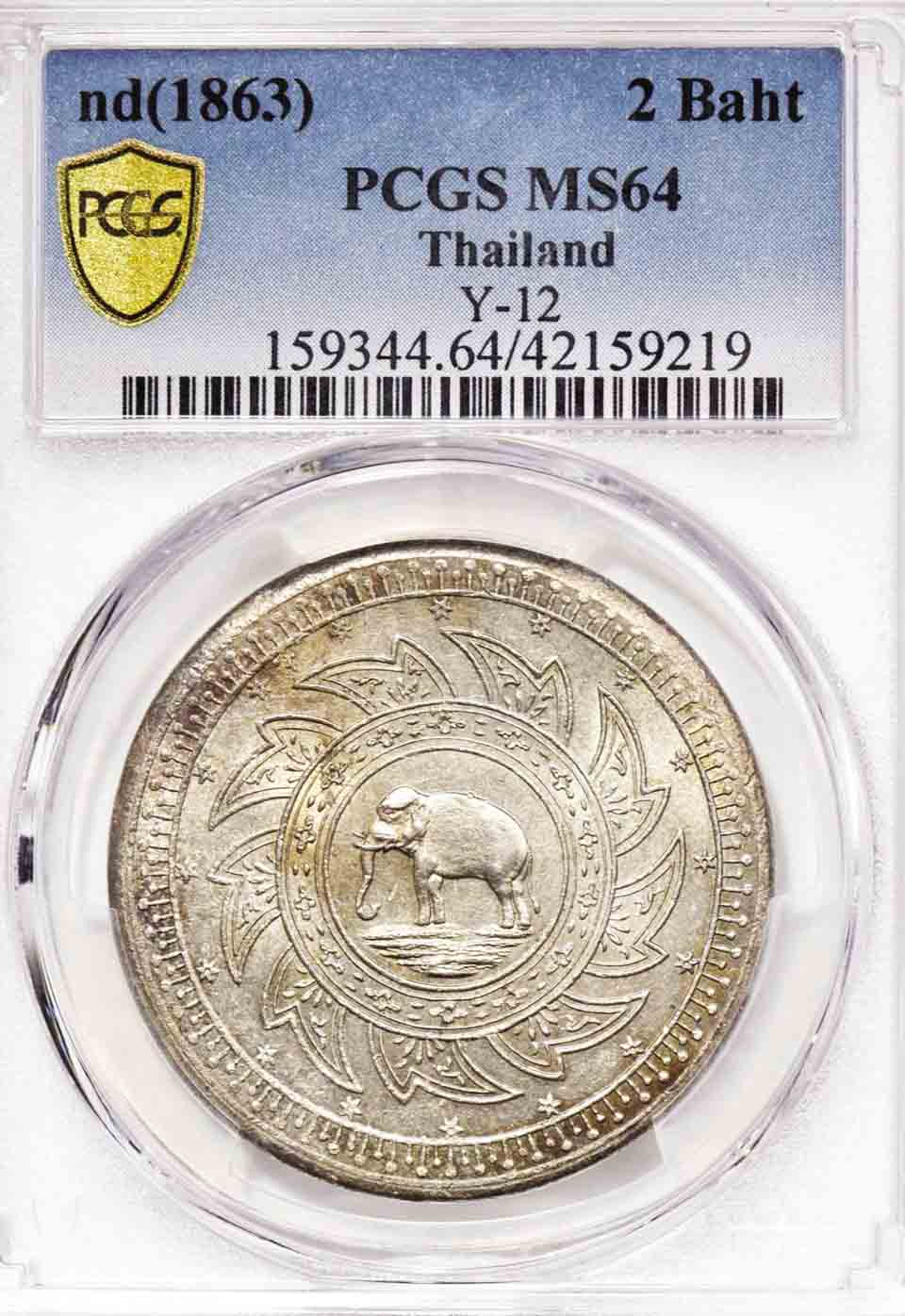

Stack‘s, Bowers and Ponterio held a huge coin auction in Hong Kong from September 28-October 7. More than 3,400 lots were offered; among them were some Thai materials. The popular 2 Baht ND (1863) struck during the reign of King Mongkut, Rama IV, was offered with an estimation of US$ 7,000 to US$ 12,000. PCGS had graded the coin to be MS64. The buyer had to pay US$ 13,000 plus commission, a total of about THB 552,000. Another 2 Baht ND (1863) was graded by PCGS to be MS63. It was estimated to US$ 5,000 to US$ 10,000, and sold for US$ 6,000 plus commission, about THB 241,000. According to the PCGS population report, they have graded 11 pcs of 2 Baht ND (1863) to be MS63 and 11 pcs to be MS64. NGC has graded 16 pcs to be MS63 and 8 pcs to be MS64. When looking at these figures in the population or census, the same coin could be graded several times in the hope of getting a better grade.

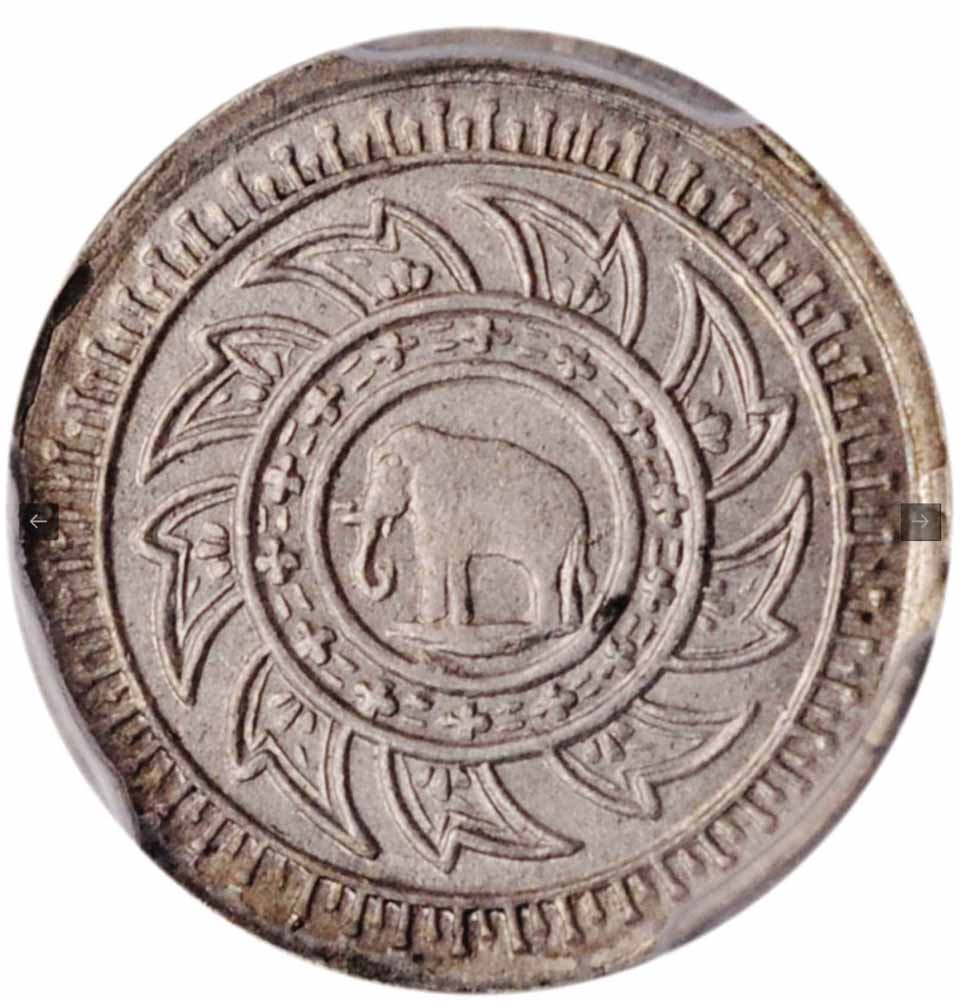

Stack´s also sold a 1/16 Baht, 1 ‘Sik’, ND (1860), graded by PCGS to be MS65. This was estimated to be US$ 1,000- 2,000 and sold for US$1,200, including commission about THB 48,000. This might look cheap comparing with the one graded by PCGS to be MS64 sold by Eur-seree in November for THB 68,000. For me the one graded MS64 looks nicer than the one graded MS65. It is important to inspect the coins prior to buying. One might not agree with the grade set by the grading company.


Thailand had for 600 years bullet coins. This is the only country that used bullet coins as a form of payment. Stack’s sold a One baht gold ND (1895), struck during the reign of King Chulalongkorn, Rama V. The weight was 15.04 grams, had Chakra and Mongkut (Royal Crown) stamps and was graded to be Choice Extremely Fine. It was estimated at only US$ 1,500-3,000 and sold for US$ 2,600 plus commission about THB 104,0000. In my opinion, a reasonable price.


MDC, Monaco, offered in their sale on October 21 a ¼ Baht ND, King Chulalongkorn, Rama V, in proof condition. The coin had been graded by PCGS to be SP65. The starting price was EURO 7,000, about THB 266.000, but there was no buyer. Looking at the picture it looks like there are a couple of scratches in front of the portrait. The starting price was also too high compared with complete sets containing proof 1/8-, ¼- and 1 Baht being sold in Thailand for THB 600,000 to THB 700,000.

Numismatica Genevensis SA on November 16 conducted an auction in Geneva, Switzerland. In the sale there were 24 impressive lots of Thai gold coins. The first lot was an 8 Baht, Tot, ND (1863) struck during the reign of King Mongkut, Rama IV (1851-1868). It was graded by NGC to be MS64 and graded by the auction company to be Good Extremely Fine. The initial starting price was CHF 4,000, about THB 172,000. Many were hoping to make a bargain, but it sold for CHF 11,000 plus commission, THB 567,000.
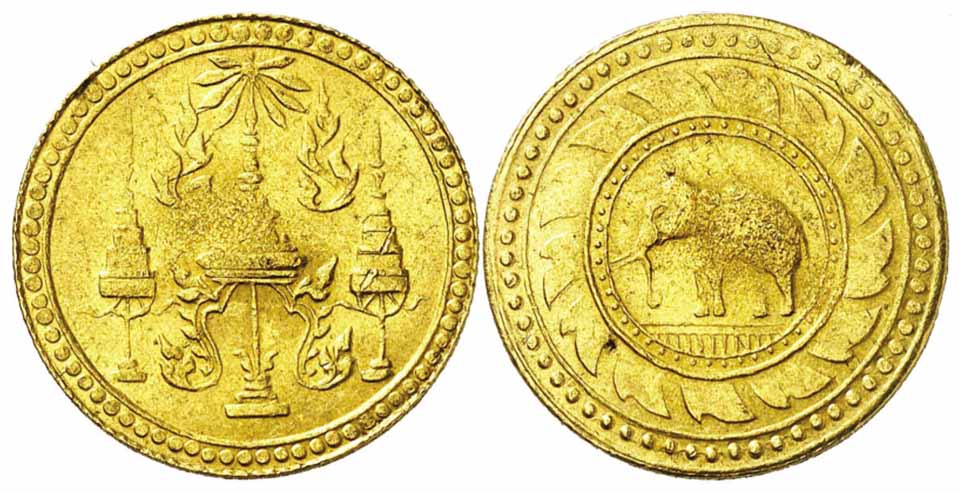
There were eight pcs of 8 Baht, Tot, ND (1863) at Numismatica Genevensis SA auction. They were graded by NGC to be from MS 64 to MS62. As usual, some were struck weakly. The coins sold from THB 567,000 to THB 412,000 for the one graded MS62. It is very rare to see these highly graded coins for sale. I have only found one 8 Baht, Tot, ND (1863) sold in Eur-seree auctions in the last few years. In auction #55 on 21st June there was one graded by NGC to be MS62, which sold for THB 360,000.

Four very nice 4 Baht, Pit, ND (1863) in the sale were graded by NGC to be MS64, MS63 and MS 62. They sold from THB 361,000 up to THB 438,000. This is well above the prices seen before.
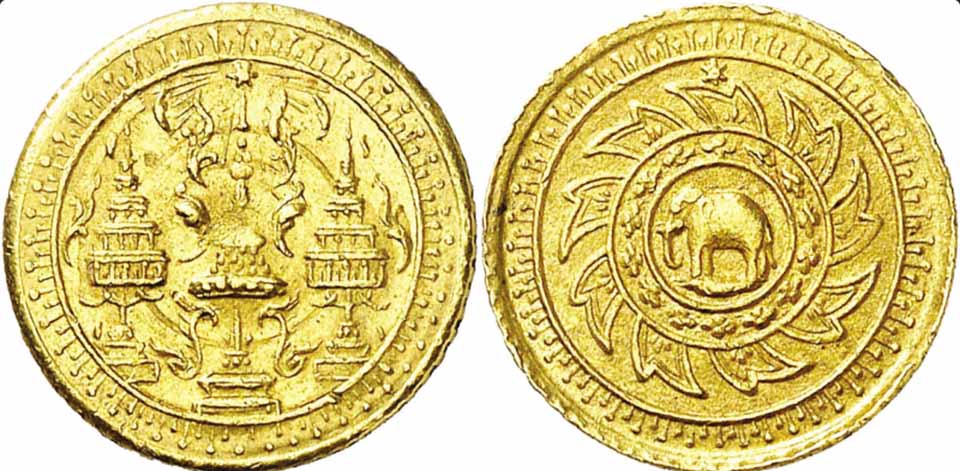
A 2.5 Baht ND (1863) was graded by NGC to be MS66 with a star. The auctioneer described it “Virtually as struck”. The starting price was CHF 2,000, bidding finished at CHF 8,000, with commission, app. THB 438,000. Another coin was also graded MS66, but without the star it was sold for THB 26,000 less.

The popular 1/8 Baht, ‘Fuang’, in gold with the portrait of King Chulalongkorn, Rama V, graded by NGC as MS63 had a starting price CHF 2,000 and with commission it sold for THB 180,600.

The last lot from Thailand was the 600-, 300- and 150 Baht gold coins from 1968 commemorating H.M. Queen Sirikit’s 36th Birthday. They had a starting price of CHF 1,000 and sold for CHF 1,200, with commission about THB 62,000.
The 24 lots of Thai coins in Numismatica Genevesis SA sold for CHF 210,903, about THB 9,000,000. The starting price was CHF 58,000. When bidding in the sale one gets the feeling that this is very expensive because of the low starting prices. But looking at the prices after the sale and considering the rarity and high quality of the coins, I am of the opinion that this is the correct price in today’s market even when they sold for almost four times the starting prices. During my 40 years of collecting Thai coins I have never seen such a collection for sale and assume there will not be another for sale in the near future.

Heritage Auctions arranged their Signature Auction in Hong Kong on the December 11-13. In the sale on the 12th there were three Thai 4 Baht ‘Tamlung’ ND, (1868-1880) silver bullet coins. One had the weight of 60.97 grams and was described to be AU/UNC. It had the Mongkut stamp and 8 dots in the Chakra. A coin with this weight is equal to a double ‘Thaler’. Including commission it was sold for about THB 121,000.
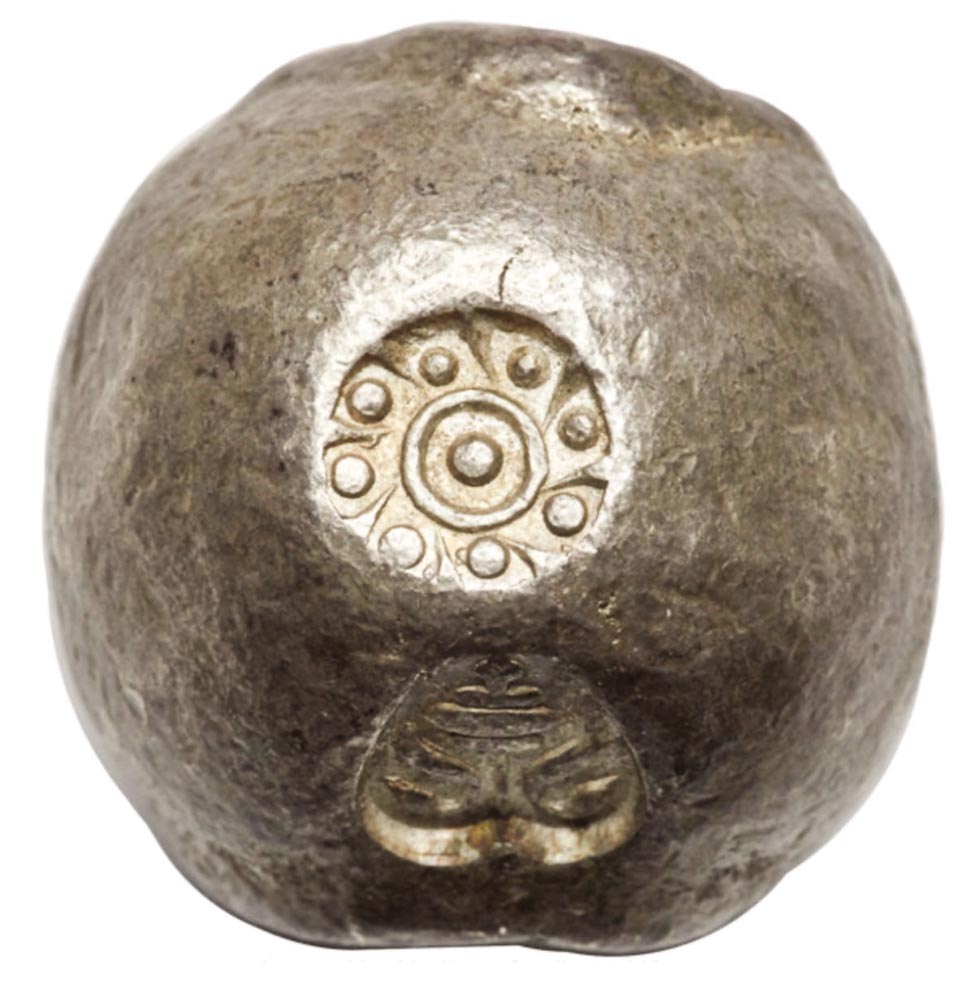


The second 4 Baht, ‘Tamlung’ ND (1868-1880) in the sale weighed 60.96 grams. It had the Mongkut stamp and 8 dots in the Chakra. It was described as being Good XF. With commission it sold for around THB 72,500.

The third 4 Baht, Tamlung, ND (1868-1880) in the sale weighed 30.34 grams. It is a restrike from the reign of King Chulalongkorn, Rama V. It had the Mongkut and Chakra stamp, which were carefully impressed alongside frosty white colour in the recesses. The quality was described to be Good XF. This coin is sometimes referred to as “official restrikes” according to the catalogue. With commission it sold for around THB 64,500.
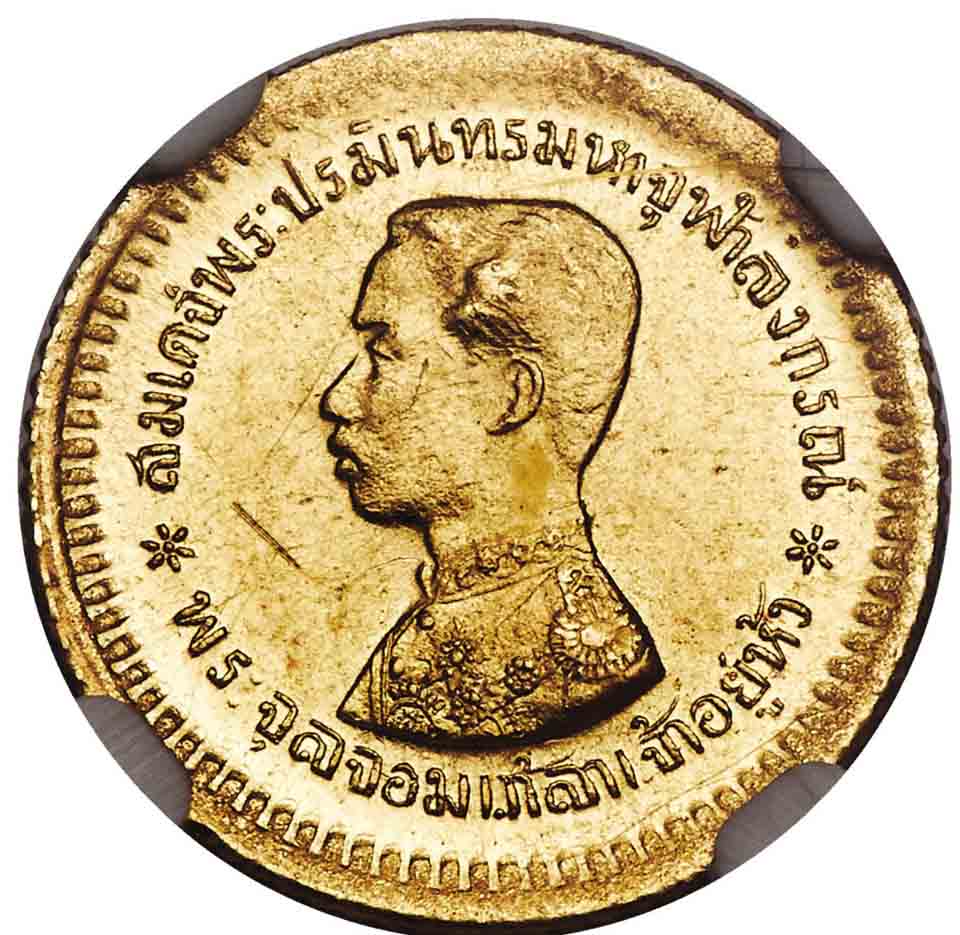

A 1/8 Baht, ‘Fuang’ ND (1876) struck during the reign of King Chulalongkorn, Rama V, graded by NGC to be MS62 sold with commission for about THB 96,700. This is about half of the price of the one sold in the Numismatica Genevensis SA on November 16. Probably the price in the Heritage sale was this low because there was a scratch in front of the portrait. The one in the Numismatica Genevesis SA sale was graded by NGC to be MS63, one grade better.
src=”https://pagead2.googlesyndication.com/pagead/js/adsbygoogle.js”>

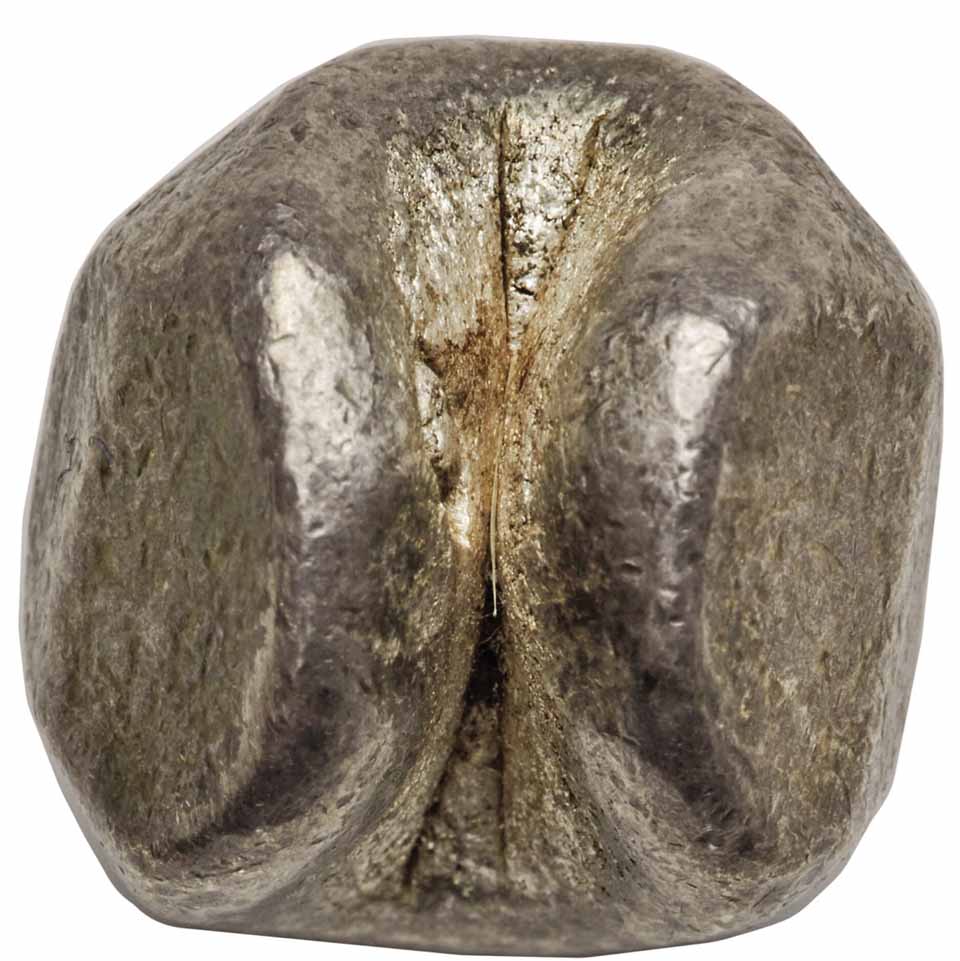
In the internet section of the auction held on 13 December, Heritage sold a 2 Baht, 1/2 ‘Tamlung’ bullet coin (1851-1868). The weight was 30.36 grams; it had the Mongkut stamp and was of a variety with 8 dots in the Chakra. The grade was GOOD XF. It was estimated to sell for US$ 300-US$500 and was sold for US$ 550 about THB 22,000 including commission.
Heritage had a turnover in their three day signature sale of around US$ 14 million, app. THB 47 million.
 |
 |
 |



